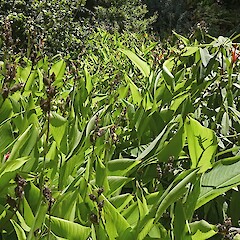Canna indica
Common name
Indian shot
Family
Cannaceae
Flora category
Vascular – Exotic
Structural class
Herbs - Monocots
NVS code
The National Vegetation Survey (NVS) Databank is a physical archive and electronic databank containing records of over 94,000 vegetation survey plots - including data from over 19,000 permanent plots. NVS maintains a standard set of species code abbreviations that correspond to standard scientific plant names from the Ngä Tipu o Aotearoa - New Zealand Plants database.
CANIND
Conservation status
Not applicable
Habitat
Terrestrial. Damp spots, wetlands, low-growing habitats, disturbed shrubland, streamsides, riversystems.
Detailed description
Erect, leafy perennial herb to 1-2 m tall. Roots rhizomatous. Stem sturdy, unbranched, hairless. Leaves on the stem, to 45 x 15 cm, oblong, with prominent midrib, sheath below. Flowers often paired, 5-6 cm long, pinkish-red and reddish-yellow, with red spots. Seed capsule round, to 2 cm, with black seeds.
Similar taxa
Hybrid cannas (Canna x generalis) have a range of forms. a. Foliage green with large yellow flowers. b. Foliage green with large showy red flowers. c. Foliage purplish with large orange flowers. Hedychium sp. (ginger) are also similar lack the strongly ribbed leaves and have multiple flowers in each inflorescence.
Flowering
November, December, February, March, April
Flower colours
Red/Pink, Yellow
Fruiting
January, March, April, May
Life cycle
Perennial. Usually spreads vegetaitively rather than by seed; seeds globose, black (Ewan Cameron 1996). Spread by dumped vegetation, soil movement, occasionally water movement.
Year naturalised
1870
Origin
West Indies, Central and South America.
Reason for introduction
Ornamental.
Tolerances
Tolerates hot to moderate temperature, damage and grazing, wind, salt, damp to mod dry. Intolerant of shade, heavy frost.
Etymology
canna: Term is derived from a Greek name for a type of reed.
References and further reading
Gardner, R. 1990. Canna. Auckland Botanical Society Journal, 45: 1-4.


